The DirectX 12 Performance Preview: AMD, NVIDIA, & Star Swarm
by Ryan Smith on February 6, 2015 2:00 PM EST- Posted in
- GPUs
- AMD
- Microsoft
- NVIDIA
- DirectX 12
DirectX 12 vs. Mantle, Power Consumption
Although the bulk of our coverage today is going to be focused on DirectX 12 versus DirectX 11, we also wanted to take a moment to also stop and look at DirectX 12 and how it compares to AMD’s Mantle. Mantle offers an interesting point of contrast being that it has been in beta longer than DirectX 12, but also due to the fact that it’s an even lower level API than DirectX 12. Since Mantle only needs to work on AMD’s GPUs and can be tweaked for AMD’s architectures, it offers AMD the chance to exploit their GPUs in a few additional ways that a common, cross-vendor API like DirectX 12 cannot.
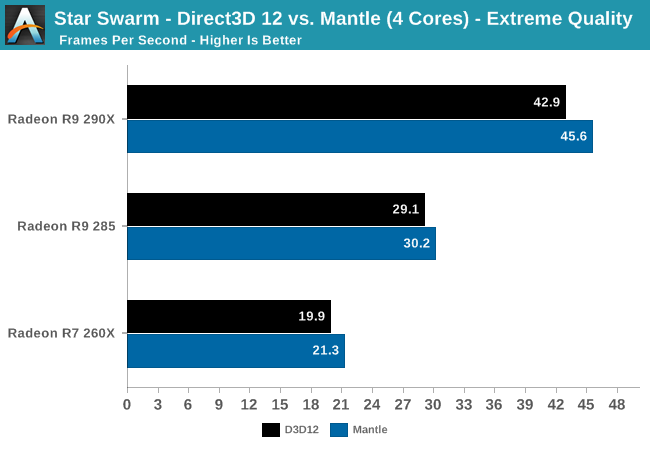
With 4 cores we find that AMD achieves better results with Mantle than DirectX 12 across the board. The gains are never very great – a few percent here and there – but they are consistent and just outside our window of variability for the Star Swarm benchmark. With such a small gain there are a number of factors that can possibly explain this outcome – better developed drivers, better developed application, further benefits of working with a known hardware platform – so we can’t credit any one factor. But it’s safe to say that at least in this one instance, at this time, Star Swarm’s Mantle rendering path produces even better results than its DirectX 12 path on AMD cards.
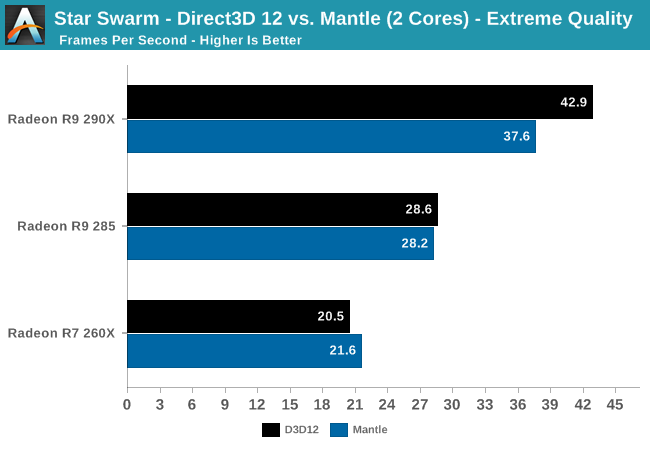
On the other hand, Mantle doesn’t seem to be able to accommodate a two-core situation as well, with the 290X seeing a small but distinct performance regression from switching to Mantle from DirectX 12. Though we didn’t have time to look at an AMD APU for this article, it would be interesting to see if this regression occurs on their 2M/4C parts as well as it does here; AMD is banking heavily on low-level APIs like Mantle to help level the CPU playing field with Intel, so if Mantle needs 4 CPU cores to fully spread its wings with faster cards, that might be a problem.

Diving deeper, we can see that part of the explanation for our Mantle performance regression may come from the batch submission process. DirectX 12 is unexpectedly well ahead of Mantle here, with batch submission taking on average a bit more than half as long as it does under Mantle. As batch submission times are highly correlated to CPU bottlenecking on Star Swarm, this would imply that DirectX 12 would bottleneck later than Mantle in this instance. That said, since we’re so strongly GPU-bound right now it’s not at all clear if either API would be CPU bottlenecked any time soon.
Update: Oxide Games has emailed us this evening with a bit more detail about what's going on under the hood, and why Mantle batch submission times are higher. When working with large numbers of very small batches, Star Swarm is capable of throwing enough work at the GPU such that the GPU's command processor becomes the bottleneck. For this reason the Mantle path includes an optimization routine for small batches (OptimizeSmallBatch=1), which trades GPU power for CPU power, doing a second pass on the batches in the CPU to combine some of them before submitting them to the GPU. This bypasses the command processor bottleneck, but it increases the amount of work the CPU needs to do (though note that in AMD's case, it's still several times faster than DX11).
This feature is enabled by default in our build, and by combining those small batches this is the likely reason that the Mantle path holds a slight performance edge over the DX12 path on our AMD cards. The tradeoff is that in a 2 core configuration, the extra CPU workload from the optimization pass is just enough to cause Star Swarm to start bottlenecking at the CPU again. For the time being this is a user-adjustable feature in Star Swarm, and Oxide notes that in any shipping game the small batch feature would likely be turned off by default on slower CPUs.
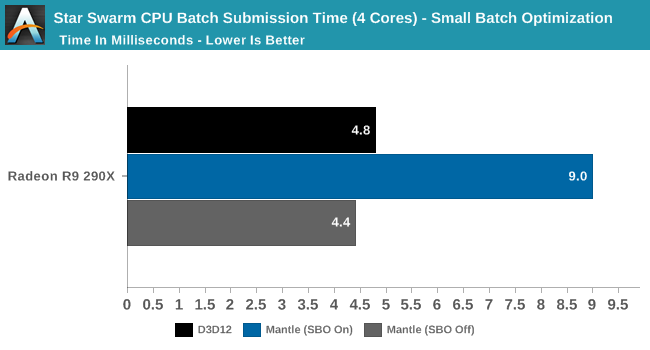
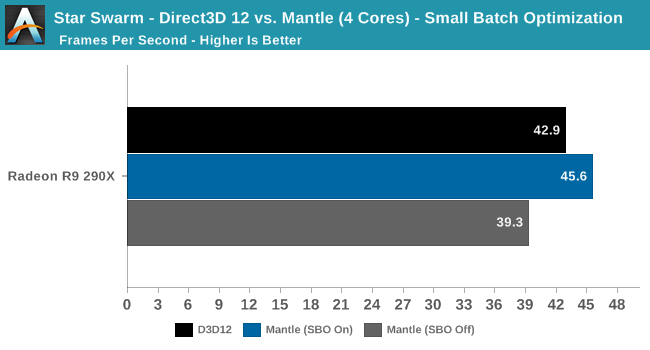
If we turn off the small batch optimization feature, what we find is that Mantle' s batch submission time drops nearly in half, to an average of 4.4ms. With the second pass removed, Mantle and DirectX 12 take roughly the same amount of time to submit batches in a single pass. However as Oxide noted, there is a performance hit; the Mantle rendering path's performance goes from being ahead of DirectX 12 to trailing it. So given sufficient CPU power to pay the price for batch optimization, it can have a signifcant impact (16%) on improving performance under Mantle.
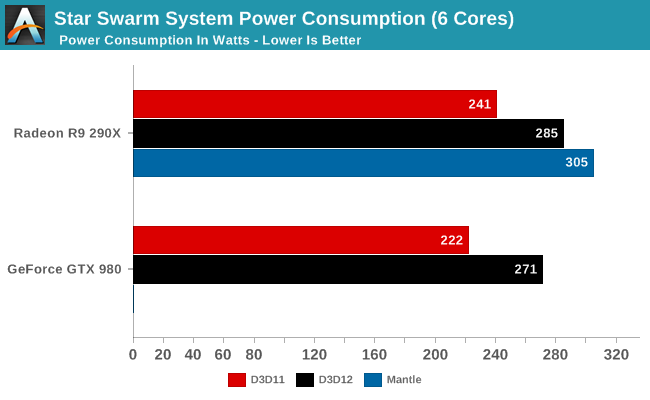
Finally, we wanted to take a quick look at power consumption among cards and APIs. To once again repeat what we said earlier, Star Swarm is an imperfect, non-deterministic benchmark, and coupled with the in-development status of DirectX 12 everything here is subject to change. However we thought this was interesting enough to include in our evaluation.
As expected, the increased throughput from DirectX 12 and Mantle drive up system power consumption. With the CPU no longer the bottleneck, the GPU never gets a chance to idle and video card power consumption ramps up to full load.










245 Comments
View All Comments
Stuka87 - Friday, February 6, 2015 - link
Very promising from the looks of it. Should help out a lot with some of these newer games.One thing I wish you would have done was to show kernel times on the CPU graphs. Would be nice to know how much of that CPU was userspace, and how much was kernel.
unacomn - Friday, February 6, 2015 - link
Very promising results for future games.I would love to see a test with AMD CPUs as well, curious if the architecture of the current AM3+ and FM2 CPUs benefits much in terms of performance from this.
Stuka87 - Friday, February 6, 2015 - link
For Mantle they benefit more, as they are a larger bottleneck. With my old AMD system (965BE @4GHz with an HD7950) BF4 was unplayable with DirectX11, but with Mantle it ran pretty decent.mikato - Friday, February 6, 2015 - link
It seems really strange to read that you couldn't run BF4 with those specs. I play the newest Call of Duty games with my 965BE (not overclocked) and my HD6950 unlocked to 6970. Settings are turned down a bit with my 1920x1200 resolution, but it runs well enough to play as twitchy fast as I need to be. I am in the market for an upgrade soon though so I can turn the settings back up.shing3232 - Friday, February 6, 2015 - link
BF4 are way more demanding than COD because there are too much object in MP especially when you playing a 64 player server.XFR - Friday, February 6, 2015 - link
Are these articles edited or proofread?JarredWalton - Friday, February 6, 2015 - link
Sometimes. I did make a reading/editing pass after this was posted, so if there are still errors let us know.Jtaylor1986 - Friday, February 6, 2015 - link
My only question is how is Mantle still in beta at this stage of the game? Microsoft seems to have developed DirectX 12 much more quickly than AMD has developed Mantlejeffkibuule - Friday, February 6, 2015 - link
It's more likely they were unknowingly developed side-by-side, but DirectX 12 was unveiled much later. Certainly if there were new DX12-only features that require special hardware, some AMD engineers would have wondered why Microsoft was requesting XYZ when developing the Xbox One SoC vs. PS4 (not that those two groups or general engineering teams would have been able to compare notes).Khato - Friday, February 6, 2015 - link
FYI - public announcement comes a long, long time after the initial specification. More importantly, directx is more of a collaboration between the players involved (Microsoft, Intel, NVIDIA, AMD) any more, not something that Microsoft develops in secret and only shares once it's finalized. Which is to say that AMD has known about the direction for directx 12 for over 2 years now.